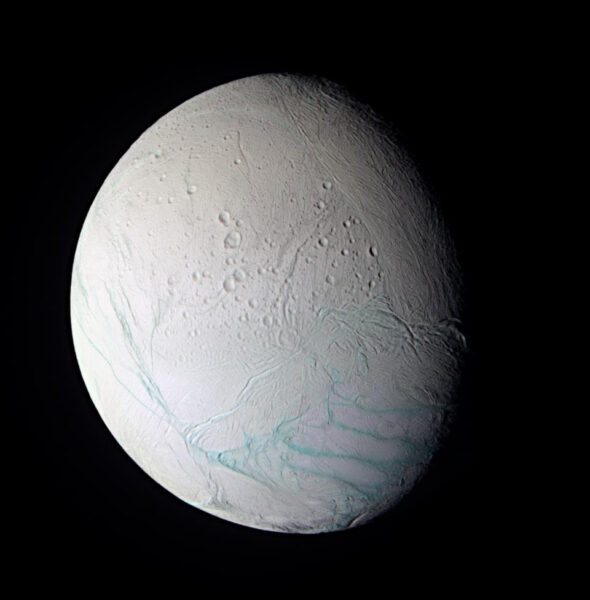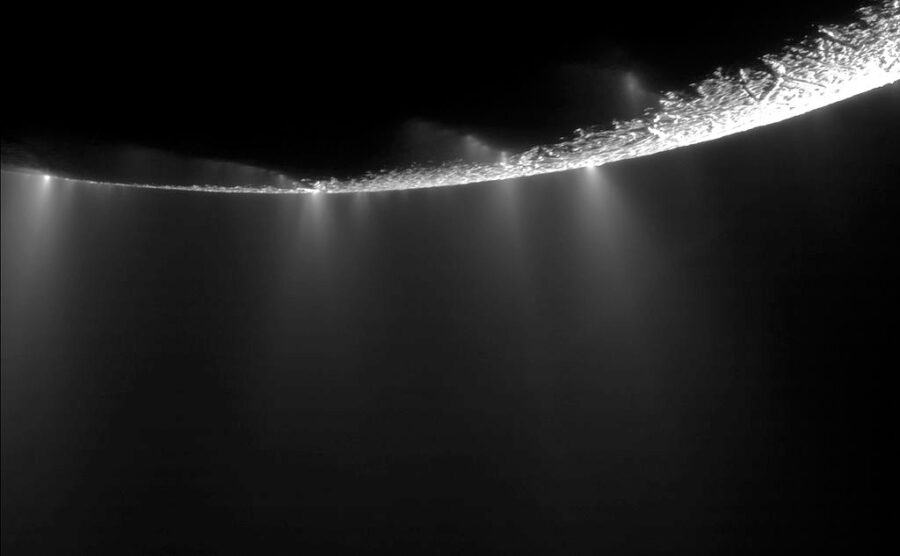The plumes erupting from Saturn’s moon Enceladus may originate in slush in the moon’s icy crust rather than its deep, subsurface ocean.
Saturn’s icy moon Enceladus harbors a subsurface ocean, and many astronomers have believed that watery plumes erupting from its surface might provide an easy way to sample it. But computer models designed for studying sea ice on Earth suggest that the plumes may have a different chemistry than the subsurface ocean.
An Icy Moon's Ocean and Plumes

NASA / JPL / Space Science Institute
The surface of Enceladus is a frigid wasteland where temperatures rarely rise above –200°C. But this moon gets squeezed and stretched by the gravitational pull of Saturn and its neighboring satellites Dione and Tethys, and the energy imparted by this tidal tug of war warms its interior.
During a close flyby of Enceladus in 2005, the Cassini spacecraft imaged geyser-like plumes of water vapor and icy particles spewing from Enceladus's south polar region. Warm water is escaping from beneath the icy crust along four rifts known as “tiger stripes.”
The fractures are 70°C warmer than the rest of the surface and expel an estimated 250 kilograms of water vapor every second at velocities as high as 2,000 kilometers per hour (1,360 mph). These cryovolcanic vents are the source of the material in Saturn's tenuous E ring, a collection of microscopic icy grains that extends between the orbits of the satellites Mimas and Titan.
Gravimetric data from Cassini's 2010 flybys revealed that an extensive ocean of liquid water lies beneath the icy shell of Enceladus, which measures as much as 30 to 40 kilometers (19 to 25 miles) thick. The satellite’s slight libration (apparent oscillation or "wobble") as it orbits Saturn suggests that this frozen crust is separated from a rocky core by a global ocean 10 to 30 kilometers deep. By comparison, Earth's ocean has an average depth of only 3.7 kilometers.
In 2015 Cassini flew through the plumes and analyzed their composition using a mass spectrometer. The presence of salts (sodium chloride and sodium carbonate) and traces of biologically interesting organic compounds in the ice was widely interpreted as compelling evidence that the plumes were erupting from pipe-like fissures that extend all the way from the surface of the icy crust to a salty subsurface ocean.
Widely regarded as one of the prime sites to hunt for extraterrestrial life, Enceladus’ ocean seemed to be accessible for future chemical and biological study by sampling the plumes rather than drilling through the thick rind of ice.
Where Do the Plumes Come From?

NASA / JPL / SSI
Hopes of easy access to the subsurface ocean were called into question at December’s meeting of the American Geophysical Union. Colin Meyer (Dartmouth College), an expert on sea ice and glaciers on Earth, presented an alternative view. By applying computer models developed for terrestrial sea ice, Meyer and his colleagues found that pockets of slushy brine produced by the localized heating of tidal stress and shear should be present within Enceladus’s icy shell.
Dissolving salts in water lowers its freezing point, and the resulting brine can percolate to the surface through porous ices, where it erupts into the vacuum. The concentration of non-volatile salts in this meltwater should increase as the water vaporizes and escapes into space. While Meyer does not doubt that a global subsurface ocean is present, he cautions that the plume’s measured saltiness “may not be representative of the ocean chemistry or the chemistry of the shell but is actually concentrated interstitial liquid.”
If sampling Enceladus’s hidden ocean proves to be more difficult than many have imagined, the designs of several proposed missions to assess its habitability may have to be revised. However, Meyer notes that pockets of slushy brine in the icy crust may be habitable zones in their own right.
 0
0









Comments
You must be logged in to post a comment.